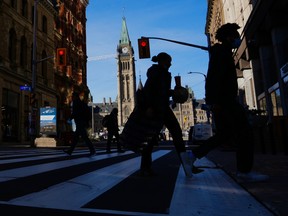The size of Canada’s public service has ballooned by 42 per cent since the 2015 election of Prime Minister Justin Trudeau

OTTAWA — The federal government added more than 10,000 employees to the federal public service last year, swelling Ottawa’s bureaucracy to record levels.
That’s down from the 21,290 new employees added to the public service ranks in fiscal year 2022-23, and 16,356 from the year previous.
The size of Canada’s public service has ballooned by 42 per cent since the 2015 election of Prime Minister Justin Trudeau, while Canada’s population increased by around 14 per cent.
Personnel spending rose steadily since the 2016-17 fiscal year, when payroll costs amounted to $40.2 billion.
That’s a 68 per cent increase in payroll spending since the Trudeau Liberals came to power in 2015.
A Treasury Board of Canada spokesperson said the size of the public service changes to adapt to priorities requirements.
“Deputy heads of federal organizations are responsible for building an appropriate workforce to fulfill their respective mandates,” the spokesperson said.
“In all cases, human resources decisions are driven by the Government of Canada’s commitment to providing quality services to Canadians.”
Annual growth of the federal public service; the spokesperson said, slowed to 2.9 percent in 2023-24, compared to 5.5 per cent between 2017 to 2023.
Franco Terrazzano, federal director of the Canadian Taxpayers Federation, described the government’s hiring spree as “out of control.”
“Everywhere you look, the cost to taxpayers is up: more bureaucrats taking bigger pay and never-ending bonuses,” he told the National Post.
“Canadians aren’t laying awake at night worried that Ottawa doesn’t have enough paper-pushers, but are worried their paycheques are stretched too thin. We don’t need more government bureaucrats, we need tax relief.”
Sharing that concern is Jake Fuss, director of fiscal studies at the Fraser Institute, who pointed out that Canada has developed a troubling habit of borrowing money to pay for a growing bureaucracy — all without consideration for service delivery.
“We did some polling recently where we found that nearly half of Canadians believe they receive poor or very poor value from the services they receive from government in exchange for the tax dollars they are paying,” he said.
“What are the actual results we’re getting from this? Right now we have declining standards of living for many Canadians, we’re seeing a GDP-per-person lower now than it was in the middle of 2019, so this isn’t actually translating into tangible, economic results for Canadians.”
Correcting the problem will require a comprehensive review of Canada’s public service to determine what’s worth keeping and what to eliminate.
“One of the things government could look at is can we return to pre-pandemic staffing levels, or work to move closer to staffing levels from 2015,” he said.
Government workers typically earn 8.5 per cent more than their private-sector counterparts, retire 2.4 years earlier, experience five times less job loss, and are nearly nine times more likely to retire with a guaranteed pension, according to the report.
“Part of that, when you’re looking at making modest spending reductions over two years to get back to a balanced budget, is actually reviewing your compensation aspects for government sector employees,” he said, adding that controlling staffing levels is also key.
“That is an area where you’re going to deal with sooner rather than later.”
National Post
Our website is the place for the latest breaking news, exclusive scoops, longreads and provocative commentary. Please bookmark nationalpost.com and sign up for our daily newsletter, Posted, here.